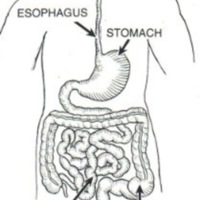Digestive System
Dublin Core
Title
Description
Our bodies need food to live and grow. The digestive system takes food and carries it to all the parts of the body.
The beginning of the digestive system is the mouth and teeth. Food that we eat has to be broken down into nutrients that cells in our bodies can use. This starts with the teeth and tongue grinding food into smaller pieces. Saliva also helps break down food.
Then the food is swallowed and goes down the esophagus, a tube that goes from the mouth to the stomach. The stomach breaks down the food further. Gastric juices that have acids and enzymes in them that help the process.
Then the food goes to the small intestine. This is a long twisting tube that fills up much of your lower abdomen area. It is where most of the digestion occurs. The liver produces bile, and the pancreas produces juices that help break food down. Small blood vessels line the walls of the small intestine. Once the food is broken down, the nutrients are absorbed by these blood vessels. The blood then carries the nutrients to cells all over the body.
The part of the food that is left moves on to the large intestine.
The beginning of the digestive system is the mouth and teeth. Food that we eat has to be broken down into nutrients that cells in our bodies can use. This starts with the teeth and tongue grinding food into smaller pieces. Saliva also helps break down food.
Then the food is swallowed and goes down the esophagus, a tube that goes from the mouth to the stomach. The stomach breaks down the food further. Gastric juices that have acids and enzymes in them that help the process.
Then the food goes to the small intestine. This is a long twisting tube that fills up much of your lower abdomen area. It is where most of the digestion occurs. The liver produces bile, and the pancreas produces juices that help break food down. Small blood vessels line the walls of the small intestine. Once the food is broken down, the nutrients are absorbed by these blood vessels. The blood then carries the nutrients to cells all over the body.
The part of the food that is left moves on to the large intestine.
Contributor
Cut Rita Zahara
Rights
Creative Commons
Type
Files
Collection
Citation
“Digestive System,” Open Educational Resources (OER) , accessed January 21, 2026, http://oer.uinsyahada.ac.id/items/show/768.


